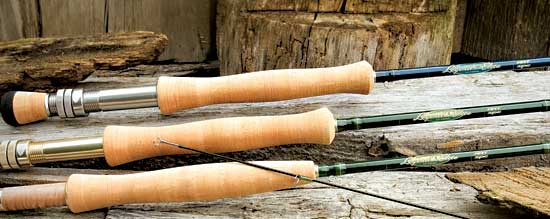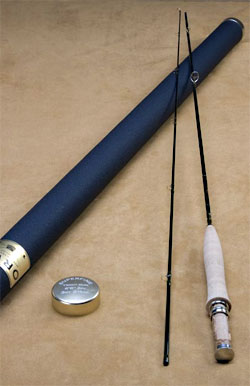Three Days With 3-Weights
WHEN PLANS for a fishing excursion begin to take shape, the first thing that I normally address is species: I think ‘bonefish,’ ‘trout,’ or bass’ and then go on to select the gear that will help me reach them and land them. On occasion, however, it’s the gear that takes me fishing — or at least inspires me to fish. On those days, I know that I don’t want to wrestle with an 11-weight rod and I’m not looking for a battle of titanic proportions, so I opt for mid-weight gear, or even the ultra-lights.
For many anglers, 4-weight fly rods mark the absolute bottom of what is commonly considered mid-weight gear, and 2-weight rods are widely considered to occupy the top end of the ultra-light scale. A quick glance at catalogs and manufacturer Web sites will also tell you that 2-weight fly rods can be readily obtained in many configurations. It’s the same for 4-weight rods too, but not for 3-weights: manufacturers generally offer them in one or two configurations and sometimes entirely neglect them altogether.

St. Croix’s Legend Elite freshwater fly rods ($410-480) offer lighter, slimmer-profile ferrules. The 3-weight proved to be suitable for the widest variety of fishing situations in our test. photo courtesy St. Croix Rod
So, why would I be “called” to fish 3-weight? For me, a 3-weight rod is all about fishing light — where the joys of small-fly delivery, small-to-medium streams and wild fish are clear motivators — but with enough muscle for fly-placing perfection and the capability to deliver a firm reply to a delicate wind.
With this in mind, I decided to spend a few days on the water with this neglected (but not forgotten) middle child — three of them, in fact. I chose models from the manufacturers’ literature, sourcing rods that subscribed to different schools of thought in terms of design, appearance and, of course, application. All the rods I picked are four-piece 3-weights (see below for full rod specifications). In the end each rod clearly reflects their manufacturer’s philosophies about fly fishing and each one provides a top-notch fishing experience — but with a few notable differences.
St. Croix Legend Elite
St. Croix designed the Legend Elite for anglers looking for a decidedly contemporary fly rod. The company site provides an overview of this technology-packed rod: IPC tooling, ART (advanced reinforcing technology), high-modulus/high-strain graphite, slim-profile ferrules, hard-anodized components, and the list goes on. On the water, the materials combination virtually eliminates residual vibration. Many newer rods are just stiff, providing the rocket-launching capacity to propel flies far off into the distance, but they also take the feel (and fun) out of casting and fishing. This blank, on the other hand, has been superbly balanced and calibrated: it addresses an angler’s need to handle the toughest of situations, including generating sufficient line speed in tight quarters, but manages to retain a high level of sensitivity. The Legend Elite ensures that you’ll be able to cover all casting and mending bases, even in a medium-sized body of water with less-than-ideal conditions: an impressive achievement for a 3-weight. The rod gives anglers a commanding feel, negotiating mends, false casting, and even roll casting with authority, yet allows anglers a light touch (small stream mends) if required. As with the other two rods, the Legend Elite’s flex characteristics show a nearly imperceptible but pleasing hint of similarity to bamboo rods.
R. L. Winston’s Boron IIt

All three 3-weights in our test showed remarkable attention to fit and finish. With the lightest touch of the three, Winston’s Boron IIt combines elegant craftsmanship with a bamboo-like feel. photo courtesy R. L. Winston Rods
Handling RL Winston’s Boron IIt for even just a few moments tells you that this rod is unquestionably New School. The boron fibers (used in the butt section of the rod) produce a pleasing balance of stiffness and flexibility. Also immediately apparent is that this rod is designed for those with a lengthy and very relaxed casting stroke. It leaves you no choice but to slow down the casting tempo. The tip section is unequalled in suppleness, and you really feel that it will go a long way in protecting an 8x tippet. It was the only rod in the group that felt like it might perform better when underlined (I did so with a Scientific Anglers 2-weight trout taper), and its characteristics came shining through: casting, roll casting, and mending improved significantly. Perhaps Winston overrated the rod’s line designation by a slight margin. In any case, this rod fits firmly in the ultra-light category, lending a relaxed, almost zen-like quality to a cast. The Winston Web site is bang-on in describing the ideal scenario for the IIt: think size 22 flies, 7x tippet, gin-clear water and fish that will spook at your shadow… The blank provides a delicate, almost nervous, anticipatory feel. Few rods in this category have a lighter feel or provide a lighter touch.

The Orvis Trout Bum rod has the power to be a good rod for mending, but still has a more traditional feel than many high-tech rods in its class. photo courtesy Orvis
Orvis Trout Bum
The Orvis Trout Bum series was developed with cutting-edge materials and technology, but with a mission to deliver a traditional, bamboo-influenced feel. Fishing one does indeed provide an “Old World” feel (for those familiar with that bamboo sensation). On the water, and unlike Winston’s IIt, I found that the Orvis 3-weight felt slightly under-rated. Their 2.5 “flex index” description includes the following: well suited for close-range, delicate casting and responds well to a gentle casting stroke. Orvis could very well have included that the rod is equally adept at mid-to-long range casts — even in a slight wind. The rod does have a full and beautifully progressive flex pattern, but the blank’s middle portion (which I believe may be the Trout Bum’s secret) is built up with just enough weight to give it the momentum to propel line, leader and fly that much farther, leading to quite a surprise if you’re expecting bamboo distance (I imagine this is where the T3 and Zero G technology comes in). Again, due to its flex characteristics, mending, especially in slower sections of a river, becomes an exact science — lengthy sections of line can be picked up and laid down without frantic rod strokes. Bonus: Orvis designers no doubt spent considerable time and effort engineering a blank and ferrules that make you swear you’re fishing a one-piece.
Overall Observations
St. Croix’s Legend Elite is your instrument of choice if there is any concern or uncertainty about fishing locations or conditions. It provides all the muscle and finesse required to deliver a fly to a spot 55 feet away with pinpoint precision.
The Winston Boron IIt will provide all of the sensitivity required to fish small-to-medium, protected pockets or stretches of water and is best used by those with a relaxed casting tempo (you know who you are).
The Orvis Trout Bum, although versatile as far as which type of water and conditions it can fish, is — perhaps predictably — best suited to those who want a rod with a traditional feel. This is a rod that that is very easy to fall in love with.
Note to anglers with larger hands: One minor annoyance with all three rods was the size of the cork grips. As with all fly rods, balance is the name of the game and fitting a 3-weight rod with a saltwater grip, to exaggerate the point, would be absurd. That said, many smaller rods — these three included — could benefit from longer grip lengths (and diameter, if at all possible) as an option to increase comfort for anglers, like me, with larger hands.
Test Specifications
Test flies: all rods tested with dry flies and weighted nymphs
Test lines: manufacturer-specified, floating, weight-forward lines (except for the Winston Boron IIt, which was tested with a WF2F line as well).
Rods:
St. Croix Legend Elite (model EFW793.4)
Length: 7’9″
Weight: 2.2 oz.
Action: Fast (mfg. designation)
MSRP: $410
More Info: http://www.stcroixrods.com
R. L. Winston Boron IIt (with nickel silver uplock and burled wood option)
Length: 8′
Weight: 2 1/8 oz.
Action: Medium (mfg. designation)
MSRP: $670
More Info: http://www.winstonrods.com
Orvis Superfine Trout Bum (Model 763-4)
Length: 7’6″
Weight: 2 3/8 oz.
Action: 2.5 flex index (full flex)
MSRP: $575
More Info: http://www.orvis.com











